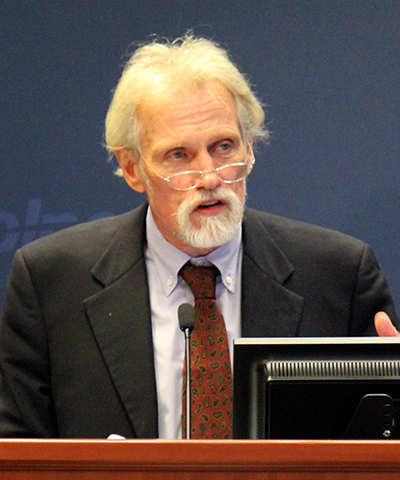User and Machine: Secrets to a Harmonious Marriage
We love our cars. They are our little red convertibles zipping along an open highway. They are our rusted-out pickups with 300,000 miles. They are our minivans piled high with soccer gear. For more than a century, Americans have had a special relationship with their wheels.
But with great leaps in automobile automation over the past decade, that relationship is suffering perhaps its most existential growing pains, according to Donald Fisher, principal technical advisor at Volpe and the third speaker in Volpe’s Reimagining Transportation speaker series.
Our cars, it seems, haven’t been holding up their end of the bargain: Making sure drivers get safely to their destinations without causing undue distractions. Of course, any relationship is a two-way street, and it is equally on drivers to operate their vehicles safely.
“Nationally, during the first six months of this year, there was a 14 percent increase in traffic fatalities, a 30 percent increase in traffic injuries, according to the National Safety Council,” Fisher said. “Older drivers are going to increase by 80 percent in the next decade; it is imperative that we do something about automobile safety.”
The crux of our growing pains with our cars is this: Where on the automation spectrum will the car of tomorrow fall? Will our vehicles be fully automated, where we as drivers are completely out of the loop, or will they act more as a safety net, leaving us still in control but applying the brakes when we’re not paying full attention?
Rebuilding the Relationship Between Car and Driver
 With short-term traffic fatalities rising, the state of the marriage between car and driver is not strong, Fisher said. A strong, forward-looking relationship needs to be built on a shared vision, with common goals and transparent communication. Manufacturers and drivers must want similar things for a future with cars that have various levels of advanced automation. Right now, whether a shared vision is possible is still an open question.
With short-term traffic fatalities rising, the state of the marriage between car and driver is not strong, Fisher said. A strong, forward-looking relationship needs to be built on a shared vision, with common goals and transparent communication. Manufacturers and drivers must want similar things for a future with cars that have various levels of advanced automation. Right now, whether a shared vision is possible is still an open question.
“We still want to remain in control of our car. A University of Michigan Transportation Research Institute study indicated that 43.8 percent of drivers didn’t want any autonomy,” Fisher said. “It was only 15.6 percent who wanted full autonomy. What do the manufacturers of the future want? They want us out of the driver’s seat. The vision doesn’t seem to be a shared one.”
Searching for Common Ground
Before agreeing on a shared vision, drivers and manufacturers need to acknowledge a few questions that are certain to arise as connected and autonomous vehicle technologies progress. For instance, there are liability issues to consider: Who is at fault in a crash caused by a self-driving vehicle?
New technologies may dazzle, but they may also be harmful. For example, heads-up global positioning displays—which project navigation and other information directly on a car’s windshield—and voice recognition technologies have been shown to create cognitive distractions, Fisher said.
“If you’re focusing on the display ahead, your eyes are on the roadway but are you going to see a little child walk out from behind those cars? The answer is almost always no,” Fisher said. “Look what that’s doing to our ability to drive. This is not a complementation—this is a failure.”
Finding a Compatible Future
Rather than a future in which the car is the chauffeur, Fisher argues that the car will be our lifeguard, and its keys will stay firmly in our hands. We love our cars too much to abandon total control. Drivers will still need to pay attention at all times, but driver-assistance technologies will help drivers avoid crashes, or reduce their severity.
But if there is one thing about the future that is certain, it is that it is thoroughly unpredictable.
“There’s not just one marriage: there are going to be many, many, many marriages in the future,” Fisher said. “Marriages between autonomous, semi-autonomous, and non-autonomous vehicles, along with marriages between the driver, the pedestrian, and the bicyclist. We at Volpe are leading the way in the attempt to better understand how in the world individuals involved this incredibly complex mix of different marriages are going to communicate with one another.”
